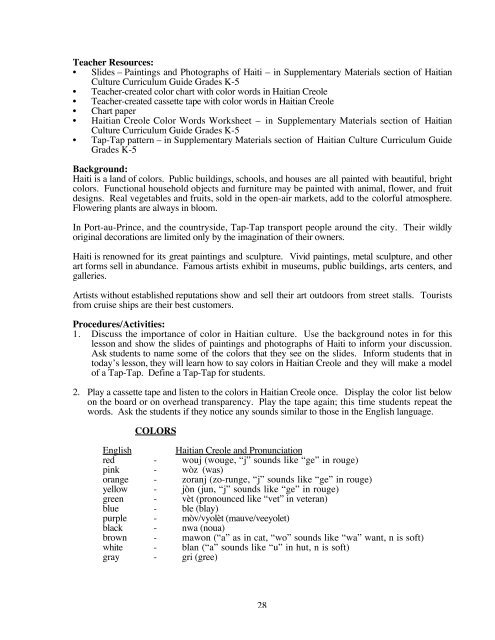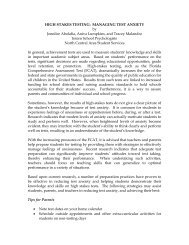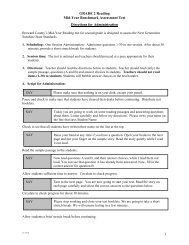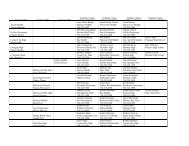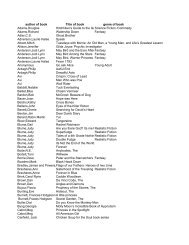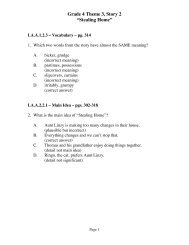Haitian Culture Curriculum Guide
Haitian Culture Curriculum Guide
Haitian Culture Curriculum Guide
You also want an ePaper? Increase the reach of your titles
YUMPU automatically turns print PDFs into web optimized ePapers that Google loves.
Teacher Resources:<br />
• Slides – Paintings and Photographs of Haiti – in Supplementary Materials section of <strong>Haitian</strong><br />
<strong>Culture</strong> <strong>Curriculum</strong> <strong>Guide</strong> Grades K-5<br />
• Teacher-created color chart with color words in <strong>Haitian</strong> Creole<br />
• Teacher-created cassette tape with color words in <strong>Haitian</strong> Creole<br />
• Chart paper<br />
• <strong>Haitian</strong> Creole Color Words Worksheet – in Supplementary Materials section of <strong>Haitian</strong><br />
<strong>Culture</strong> <strong>Curriculum</strong> <strong>Guide</strong> Grades K-5<br />
• Tap-Tap pattern – in Supplementary Materials section of <strong>Haitian</strong> <strong>Culture</strong> <strong>Curriculum</strong> <strong>Guide</strong><br />
Grades K-5<br />
Background:<br />
Haiti is a land of colors. Public buildings, schools, and houses are all painted with beautiful, bright<br />
colors. Functional household objects and furniture may be painted with animal, flower, and fruit<br />
designs. Real vegetables and fruits, sold in the open-air markets, add to the colorful atmosphere.<br />
Flowering plants are always in bloom.<br />
In Port-au-Prince, and the countryside, Tap-Tap transport people around the city. Their wildly<br />
original decorations are limited only by the imagination of their owners.<br />
Haiti is renowned for its great paintings and sculpture. Vivid paintings, metal sculpture, and other<br />
art forms sell in abundance. Famous artists exhibit in museums, public buildings, arts centers, and<br />
galleries.<br />
Artists without established reputations show and sell their art outdoors from street stalls. Tourists<br />
from cruise ships are their best customers.<br />
Procedures/Activities:<br />
1. Discuss the importance of color in <strong>Haitian</strong> culture. Use the background notes in for this<br />
lesson and show the slides of paintings and photographs of Haiti to inform your discussion.<br />
Ask students to name some of the colors that they see on the slides. Inform students that in<br />
today’s lesson, they will learn how to say colors in <strong>Haitian</strong> Creole and they will make a model<br />
of a Tap-Tap. Define a Tap-Tap for students.<br />
2. Play a cassette tape and listen to the colors in <strong>Haitian</strong> Creole once. Display the color list below<br />
on the board or on overhead transparency. Play the tape again; this time students repeat the<br />
words. Ask the students if they notice any sounds similar to those in the English language.<br />
COLORS<br />
English <strong>Haitian</strong> Creole and Pronunciation<br />
red - wouj (wouge, “j” sounds like “ge” in rouge)<br />
pink - wòz (was)<br />
orange - zoranj (zo-runge, “j” sounds like “ge” in rouge)<br />
yellow - jòn (jun, “j” sounds like “ge” in rouge)<br />
green - vèt (pronounced like “vet” in veteran)<br />
blue - ble (blay)<br />
purple - mòv/vyolèt (mauve/veeyolet)<br />
black - nwa (noua)<br />
brown - mawon (“a” as in cat, “wo” sounds like “wa” want, n is soft)<br />
white - blan (“a” sounds like “u” in hut, n is soft)<br />
gray - gri (gree)<br />
28


